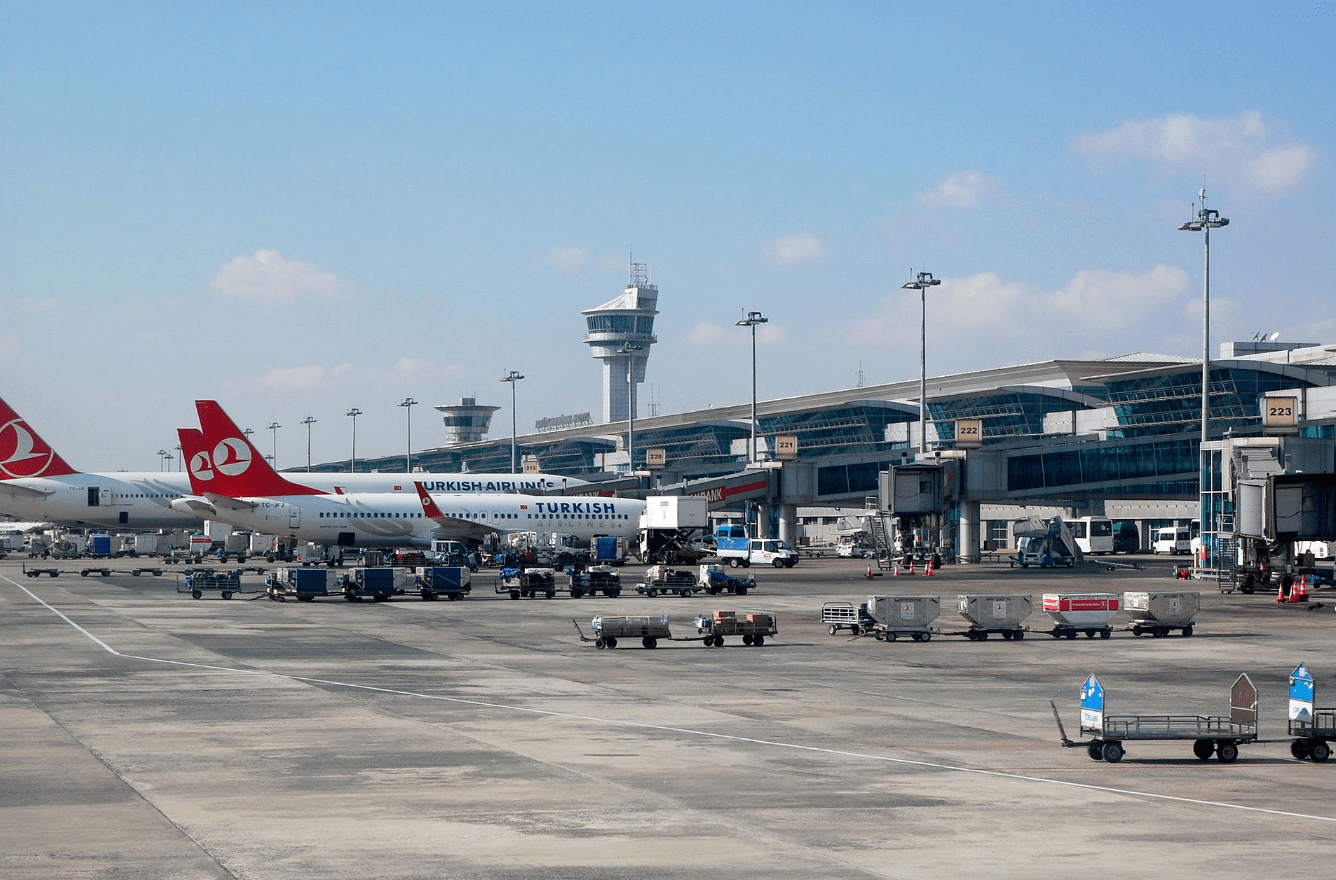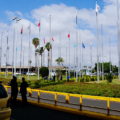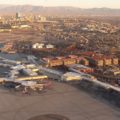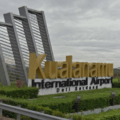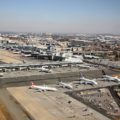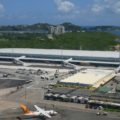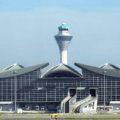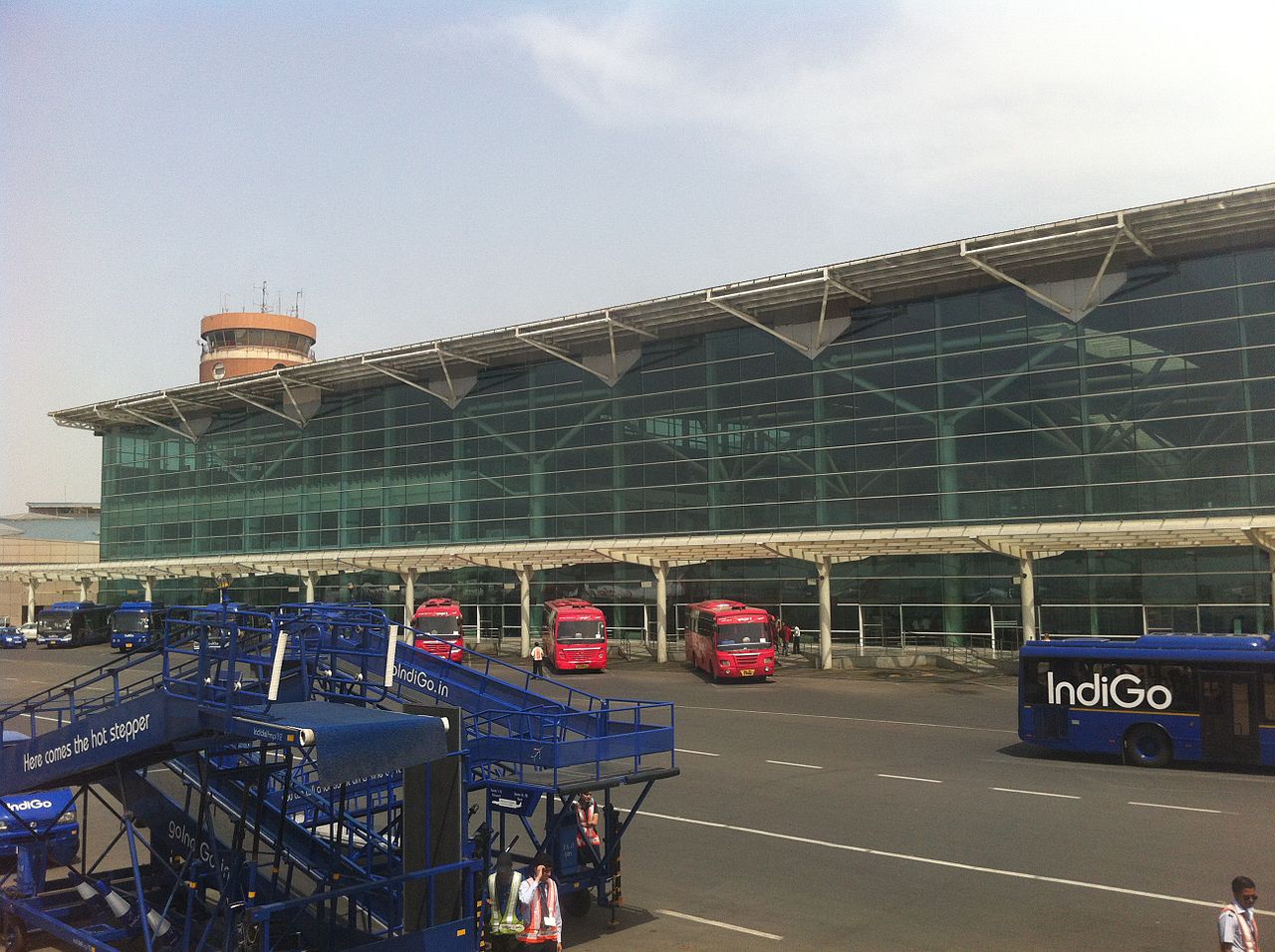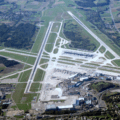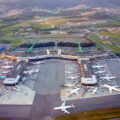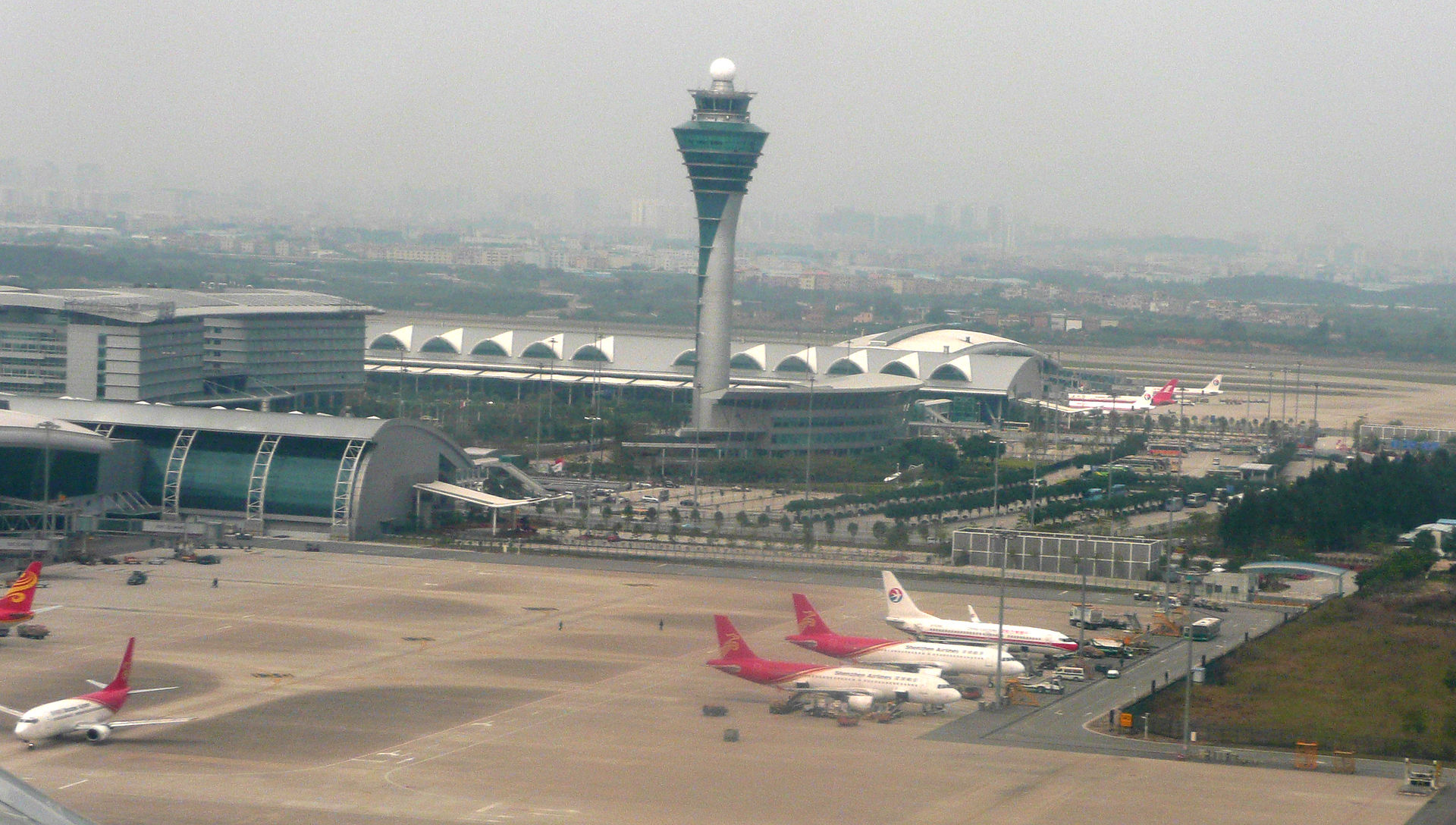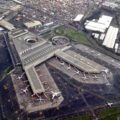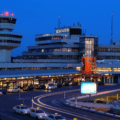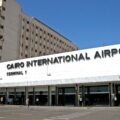Aviation
Tel Aviv Ben Gurion Airport
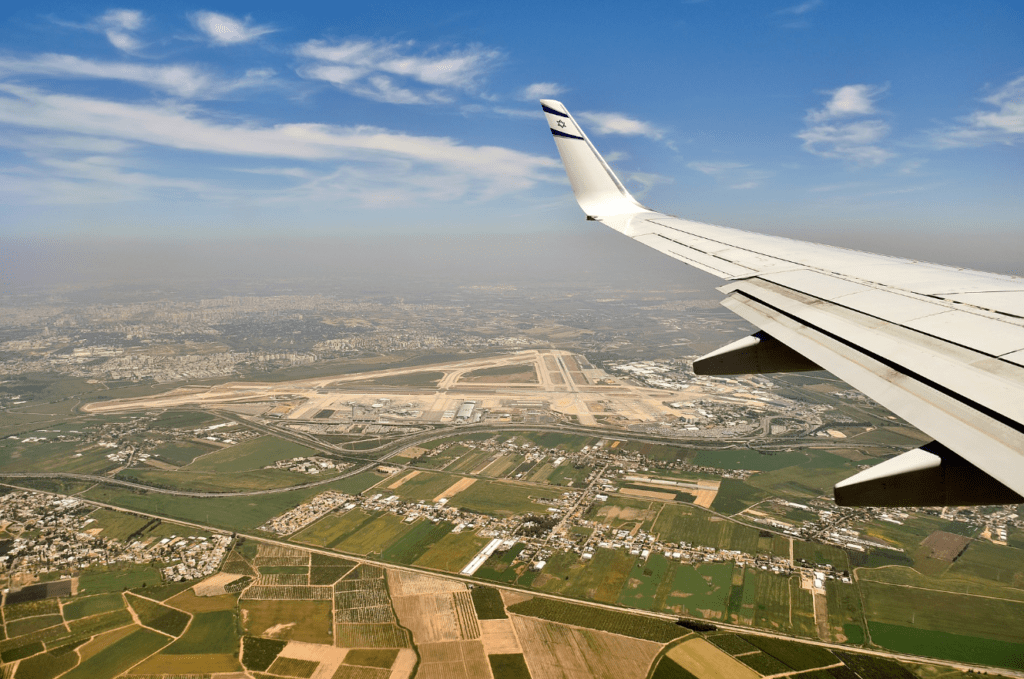
Source: Bahnfrend
| IATA: TLV ICAO: LLBG | |
| Airport type | Public |
| Operator | Israel Airports Authority |
| Serves | Tel Aviv metropolitan area and Jerusalem |
| Location | Central District, Israel |
| Hub for | Arkia CAL Cargo Air Lines El Al Israir Airlines Sun D’Or |
| Elevation AMSL | 134 ft / 41 m |
| Coordinates | |
| Website | iaa.gov.il |
Ben Gurion Airport (Hebrew: נמל התעופה בן-גוריון; Arabic: مطار بن غوريون الدولي) (IATA: TLV, ICAO: LLBG), commonly known by its Hebrew acronym as Natbag (נתב״ג), is the main international airport of Israel and the busiest airport in the country, located on the northern outskirts of the city of Lod, which is about 45 km (28 mi) northwest of Jerusalem and 20 km (12 mi) to the southeast of Tel Aviv. Renamed in 1973 after Israel’s first Prime Minister: David Ben-Gurion, the airport serves as a hub for El Al, Israir Airlines, Arkia, and Sun D’Or. It is operated by the Israel Airports Authority: a government-owned corporation that manages all public airports and border crossings in Israel.
In 2019, Ben Gurion handled 24.8 million passengers. The airport is considered to be among the five best airports in the Middle East due to its passenger experience and its high level of security. Security forces such as Israel Police officers, IDF and Israel Border Police soldiers are complemented by airport security guards who operate both in uniform and undercover. The airport has been the target of several terrorist attacks, but no attempt to hijack a plane departing from Ben Gurion airport has ever succeeded.
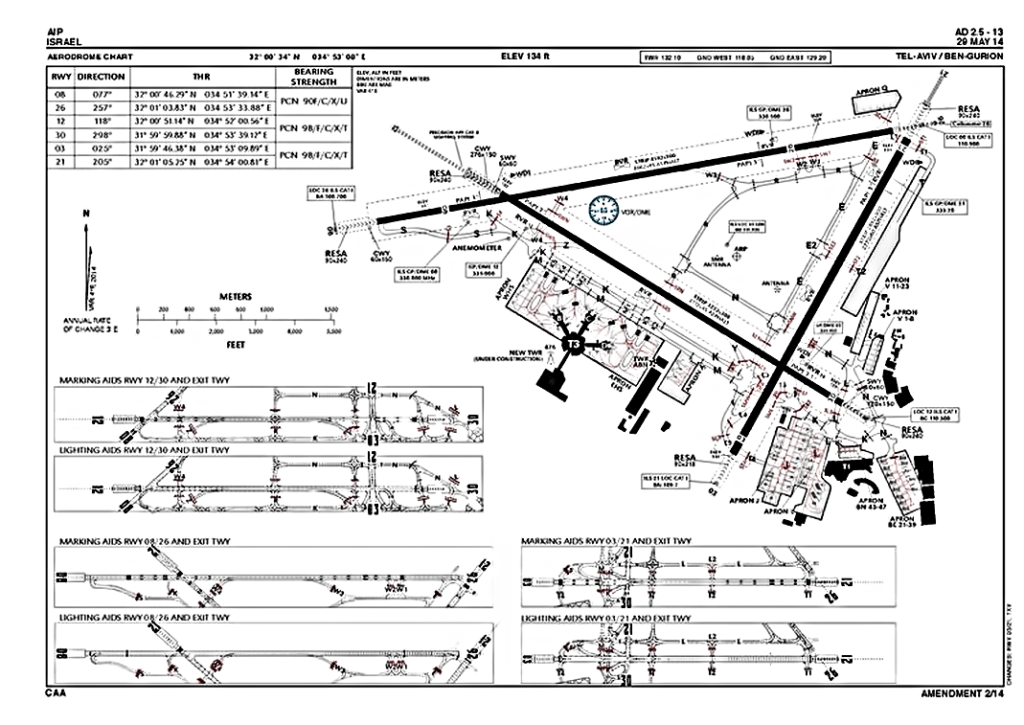

Source: Israel Civil Aviation Authority
Passenger terminals
Terminal 1
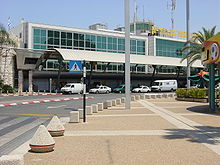

Source: VOrash
History
Prior to the opening of Terminal 3, Terminal 1 was the main terminal building at Ben Gurion Airport. At that time, the departures check-in area was located on the ground floor. From there, passengers proceeded upstairs to the main departures hall, which contained passport control, duty-free shops, VIP lounges, one synagogue and boarding gates. At the gates, travelers would be required to descend a flight of stairs to return to the ground floor where waiting shuttle buses transported them to airplanes on the tarmac. The arrivals hall with passport control, luggage carousels, duty-free pick-up and customs was located at the south end of the building. The shuttle-buses transferred passengers and crews to and from the terminal to airplanes which were parked on the tarmac over 500 m (1,600 ft) away. After Terminal 3 opened, Terminal 1 was closed except for domestic flights to the airport in Eilat and government flights such as special immigrant flights from North America and Africa. Chartered flights organised by Nefesh B’Nefesh carrying immigrants from North America and England use this terminal for their landing ceremonies several times a year.
Although Terminal 1 was closed between 2003 and 2007, the building served as a venue for various events and large-scale exhibitions including the “Bezalel Academy of Arts Centennial Exhibition” which was held there in 2006. The renovations for the terminal were designed by Yosef Assa with three individual atmospheric themes. Firstly, the public halls have a Land-of-Israel character with walls painted in the colors of Israel’s Judean, Jerusalem and Galilee mountains. The Departure Hall is given an atmosphere of vacation and leisure, whilst the Arrivals Hall is given a more urban theme as passengers return to the city.
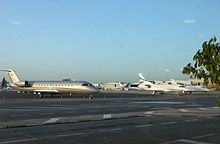

Source: Ori~
In February 2006, the Israel Airports Authority announced plans to invest 4.3 million NIS in a new VIP wing for private jet passengers and crews, as well as others interested in avoiding the main terminal. VIP ground services already exist, but a substantial increase in users has justified expanding the facilities, which will also boost airport revenues. The IAA released figures showing significant growth in private jet flights (4,059, a 36.5% increase from 2004) as well as private jet users (14,613, a 46.2% increase from 2004). The new VIP wing, operated by an outside licensee, will be located in an upgraded and expanded section of Terminal 1. All flight procedures (security check, passport control and customs) will be handled here. This wing will include a hall equipped for press conferences, a deluxe lounge, special meeting rooms equipped with state-of-the-art business facilities and a designated lounge for flight crews who spend time at the airport between flights.[19] It was announced in January 2008, however, that the IAA planned to construct a new 1000 square metre VIP terminal next to Terminal 3.
International low-cost and domestic terminal


Source: Michaelg2588
Terminal 1 was closed in 2003 and re-opened in 2007 as the domestic terminal following extensive renovations, and in July 2008, to cater for summer charter and low-cost flights. It remained open for these charter and low-cost flights for the 2008 summer season then temporarily closed in October 2008, when it underwent further renovation and reopened again in Summer 2009, when it was expected to reach a three-month capacity of 600,000 passengers on international flights. As of 2010, several low-cost carriers’ international flights were operating out of Terminal 1 year-round including Vueling flights to Barcelona and easyJet flights to London (Luton), Manchester, Geneva, and Basel. In 2015, due to increased demand and following another expansion of the terminal, the Israel Airports Authority made Terminal 1 available to all low-cost carriers under certain conditions. Flights operating out of Terminal 1 are charged lower airport fees than those operating out of Terminal 3.
Until the summer of 2017 Terminal 1 was used for flight check-in, security screening and passport-control for international flights for passengers of certain low-cost airlines, but following passport control passengers were bussed to the departures concourse of Terminal 3 from which they boarded their flights. All incoming flights for airlines operating out of Terminal 1 were handled in Terminal 3. However, beginning on 19 June 2017 and following several months of renovations, Terminal 1 passengers began being bussed directly to their flights from Terminal 1, although incoming passengers continue to be handled in Terminal 3. The renovations to Terminal 1’s boarding area included adding duty-free shops, restaurants and cafes. The terminal was also equipped with advanced checked-baggage handling and screening systems, similar to those in Terminal 3.
A free public shuttle from Terminal 3 and the railway station to and from Terminal 1 operates approximately every 15 to 30 minutes (depending on the time of day).
Terminal 3


Source: Overflying Ben Gurion Airport


Source: GeorgeDement
Terminal 3, which opened on 28 October 2004, replaced Terminal 1 as the main international gateway to and from Israel. The building was designed by Skidmore, Owings & Merrill (SOM). Moshe Safdie & Associates[28] and TRA (now Black and Veatch) designed a linking structure and the airside departure areas and gates. Ram Karmi and other Israeli architects were the local architects of record. The inaugural flight was an El Al flight to John F. Kennedy International Airport in New York City.
Work on Natbag 2000, as the Terminal 3 project was known, was scheduled for completion prior to 2000 in order to handle a massive influx of pilgrims expected for the Millennium celebrations. This deadline was not met due to higher than anticipated costs and a series of work stoppages in the wake of the bankruptcy of the main Turkish contractor. The project eventually cost an estimated one billion US dollars. Due to the proximity of the airport to the country’s largest population centres and the problem of noise pollution, another international airport is being considered to be built elsewhere in the country,[29] such as the new Ilan and Assaf Ramon Airport in Southern Israel.
Terminal 3 uses the Jetway system. The overall layout is similar to that of airports in Europe and North America, with multiple levels and considerable distances to walk after disembarking from the aircraft. The walk is assisted by escalators and moving walkways. The upper level departures hall, with an area of over 10,000 m2 (110,000 sq ft), is equipped with 110 check-in counters and as well as flight information display systems. A small shopping mall, known as Buy & Bye, is open to both travellers and the general public. The mall, which includes shops, restaurants and a post office, was planned to be a draw for non-flyers too. On the same level as the mall, passengers enter passport control and the security check. Planes taking off and landing can be viewed from a distinctive tilted glass wall. The arrivals hall is located on the ground floor where there are also 20 additional check-in counters (serving Star Alliance airlines). Car rental counters are located in an intermediate level situated between the departing and arriving passenger halls. Terminal 3 has two synagogues.


Source: Manuel Schneider
After the main security check, passengers wait for their flights in the star-shaped duty-free rotunda. A variety of cafes, restaurants and duty-free shops are located there, open 24 hours a day, as well as a synagogue, banking facilities, a transit hall for connecting passengers and a desk for VAT refunds.
Terminal 3 has a total of 40 gates divided among four concourses (B, C, D, and E), each with 8 jetway-equipped gates (numbered 2 through 9), as well as two stand gates (bus bays 1 and 1A) from which passengers are ferried to aircraft. Concourses B, C, and D were opened when terminal 3 opened in 2004, while concourse E was completed in 2018. Space exists for one additional concourse (A) at Terminal 3.
Free wireless internet is provided throughout the terminal. The terminal has three business lounges—the exclusive El Al King David Lounge for frequent flyers and three Dan lounges for either privileged or paying flyers.
In January 2007, the IAA announced plans for a 120-bed hotel to be located about 300m west of Terminal 3. The tender for the hotel was published by the IAA in late 2017. The winning bidder will construct and operate the hotel for a period of 25 years.
Former and unopened terminals
Terminal 2
Terminal 2 was inaugurated in 1969 when Arkia resumed operations at the airport after the Six-Day War. Terminal 2 served domestic flights until 20 February 2007 when these services moved into the refurbished Terminal 1. Due to increased traffic in the late 1990s and over-capacity reached at Terminal 1, an international section was added until Terminal 3 was opened. After the transfer of domestic services to Terminal 1, Terminal 2 was demolished in order to make room for additional air freight handling areas.
Terminal 4
This terminal, built in 1999, was meant to handle the crowds expected in 2000, but never officially opened. To date, it has only been used as a terminal for passengers arriving from Asia during the SARS epidemic. Another use for the terminal was for the memorial ceremonies upon the arrival of the casket of Col. Ilan Ramon after the Space Shuttle Columbia disaster in February 2003 and the arrival of Elhanan Tannenbaum and the caskets of 3 Israeli soldiers from Lebanon in January 2004.
Future development
In December 2017, the IAA announced a long-term expansion plan for Ben Gurion Airport estimated to cost approximately NIS 9 billion. Plans include further expansion of Terminal 1, a new dedicated domestic flights terminal, a major expansion of Terminal 3’s landside terminal which would add approximately 90 additional check-in counters, construction of Concourse A, and additional aircraft parking spaces and ramps. In addition, air cargo facilities would be relocated to a large, currently-unused tract of land in the northern part of the airport’s property (north of runway 08/26) where additional aircraft maintenance facilities would also be built.
In the meantime, to ease immediate overcrowding problems at Terminal 3’s landside terminal, in the Spring of 2018 a temporary large, air-conditioned tent was erected adjacent to Terminal 3 housing 25 check-in counters and security screening facilities.
In August 2018, the IAA published a tender for the construction and operation of a new terminal, dedicated to handling private and executive aircraft traffic.
Office buildings
The Airport City development, a large office park, is located east of the main airport property. It is at the junction of the Jerusalem, and Tel Aviv metropolitan areas.
The head office of El Al is located at Ben Gurion Airport, as is the head office of the Israel Airports Authority.
The head offices of the Civil Aviation Authority and CAL Cargo Air Lines are located in the Airport City office park nearby the airport.
In addition, Israel Aerospace Industries also maintains its head office on airport grounds as well as extensive aviation construction and repair facilities.
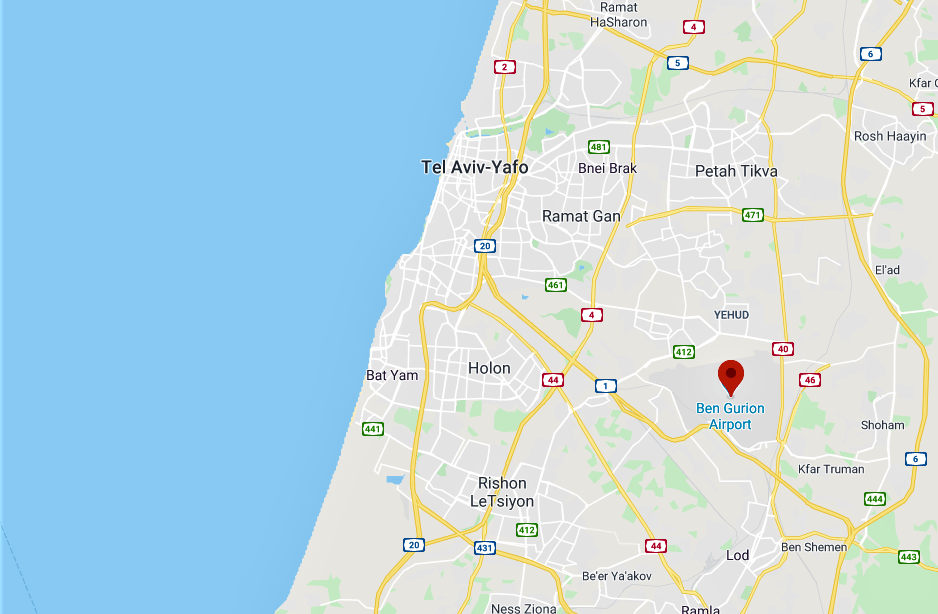

Runways
Main runway
The closest runway to terminals 1 and 3 is 12/30, 3,112 m (10,210 ft) in length, and is followed by a taxiway. Most landings take place on this runway from West to East, approaching from the Mediterranean Sea over southern Tel Aviv. During inclement weather, it may also be used for takeoffs (Direction 12). A 17 million NIS renovation project was completed in November 2007 which reinforced the runway and made it suitable for future wide-body aircraft. In September 2008, a new ILS serving the runway was activated. The main runway was closed from 2011 until early 2014 in order to accommodate the extension of runway 03/21 and other construction activity in the vicinity of the runway.
Short runway
When it was originally built, the short runway (direction 03/21) was 1,780 m (5,840 ft) long, making it too short to accommodate most mainline passenger jets. At the time it mainly served cargo aircraft of the Israeli Air Force and as a taxiway for runway 26. However, by late 2011, the runway was closed and most of the activity in the military apron to the east of the runway was permanently relocated to the Nevatim Airbase in southern Israel. In late May 2014 the runway was reopened after having been rebuilt and lengthened to 2,772 m (9,094 ft), allowing it to handle most types of aircraft. It is equipped with an ILS and mostly handles landings from north to south.
Quiet runway
The longest runway at the airfield, 4,062 m (13,327 ft), and the main take off runway from east to west (direction 08/26), is referred to as “the quiet runway” since jets taking off in this direction produce less noise pollution for surrounding residents[vague]. A 24 million NIS renovation project completed in February 2006 reinforced the runway and made it suitable for wide-body aircraft such as Airbus A380.
History and development
The original layout of the airfield as designed by the British in the 1930s included four intersecting 800 m runways suitable for the piston engined aircraft of the day. However, none of this original layout is visible nowadays since as usage increased and aircraft types and needs changed over the years various runways on the airport’s premises were built and removed.
The main runway (12/30) is the oldest surviving runway in the airport, with the quiet (08/26) and short (03/21) runways having been built in the late 1960s and 1970s. Since very little commercial traffic could operate on the short runway, it meant that for approximately forty years, the airport mostly relied on runways 12/30 and 08/26. This presented a problem however; the fact that these two runways intersect near their western end creates a crisscross pattern between aircraft landing and taking off. This pattern reduces the number of aircraft which can arrive to and depart from the airport and has detrimental safety implications as well.
With passenger traffic projected to increase, plans were drawn in the 1980s and 90s for the extension of runways 03/21 and 08/26 as a means of alleviating some of Ben Gurion’s safety and capacity concerns. These plans were approved in 1997 and construction began in 2010. The extension of runway 03/21 allows the airport to operate in an “open V” configuration, allowing for simultaneous landings and take offs on runways 08/26 and 03/21 and thus more than double the number of aircraft movements which can be handled at peak times, while increasing the overall level of air safety in and around the airport. Construction took four years and cost 1 billion NIS (financed from the Israeli Airports Authority budget) and was completed 29 May 2014. It included paving 22 kilometers of runways and taxiways, using more than 1.5 million tons of asphalt, laying one million meters of runway lighting cables, 50,000 meters of high-voltage power lines and 10,000 light fixtures. The construction of several new taxiways between the existing runways and terminals also significantly reduced taxi times at the airport.
Citizen objections
While Ben Gurion Airport is conveniently located in the very center of the country, this fact also means that the airport is surrounded by various residential communities who often complain of noise pollution caused by the airport. Following the completion of the extension of runway 03/21, residents north of the airport sued the Israeli aviation authorities claiming that the authorities intend to use the runway to a greater degree than was originally agreed with them during the approval process for the airport runways’ reconfiguration project.
Security procedures
Overview
Ben Gurion International Airport has been said to be the world’s most secure airport. Security operates on several levels.
All cars, taxis, buses and trucks go through a preliminary security checkpoint before entering the airport compound. Armed guards spot-check the vehicles by looking into cars, taxis and boarding buses, exchanging a few words with the driver and passengers. Armed security personnel stationed at the terminal entrances keep a close watch on those who enter the buildings. If someone arouses their suspicion or looks nervous, they may strike up a conversation to further assess the person’s intent. Plainclothes armed personnel patrol the area outside the building, and hidden surveillance cameras operate at all times. Inside the building, both uniformed and plainclothes security officers are on constant patrol. Departing passengers are personally questioned by security agents even before arriving at the check-in desk. This interview can last as little as a minute, or as long as an hour if a passenger is selected for additional screening. Luggage and body searches may be conducted.
Until August 2007, there was a system of color codes on checked baggage but the practice was discontinued after complaints of discrimination. In the past, checked baggages were screened following the personal interview and before passengers arrived at the check-in desks. Occasionally, if security assessed a person as a low risk, they were passed straight through to the check-in desks, bypassing the main X-ray machines, a practice which also drew some discrimination complaints. This process ceased in April 2014 when the main X-ray machines were removed from the passenger queuing area in terminal 3 and baggage screening began being performed after the baggage was checked-in by airline representatives (as is common in most airports around the world). Terminal 1 began using the same procedure in summer 2017.
Baggage screening
After check-in, all checked baggage is screened using sophisticated X-ray and CT scanners and put in a pressure chamber to trigger any possible explosive devices. Following the check-in process, passengers continue to personal security and passport control. Before passing through the metal detectors and putting carry-on baggage through the X-ray machine at the security checkpoint, passports and boarding passes are re-inspected and additional questions may be asked. Before boarding the aircraft, passports and boarding passes are verified once again. Security procedures for incoming flights are not as stringent, but passengers may be questioned by passport control depending on country of origin, or countries visited prior to arrival in Israel. Passengers who have recently visited Arab countries are subject to further questioning.
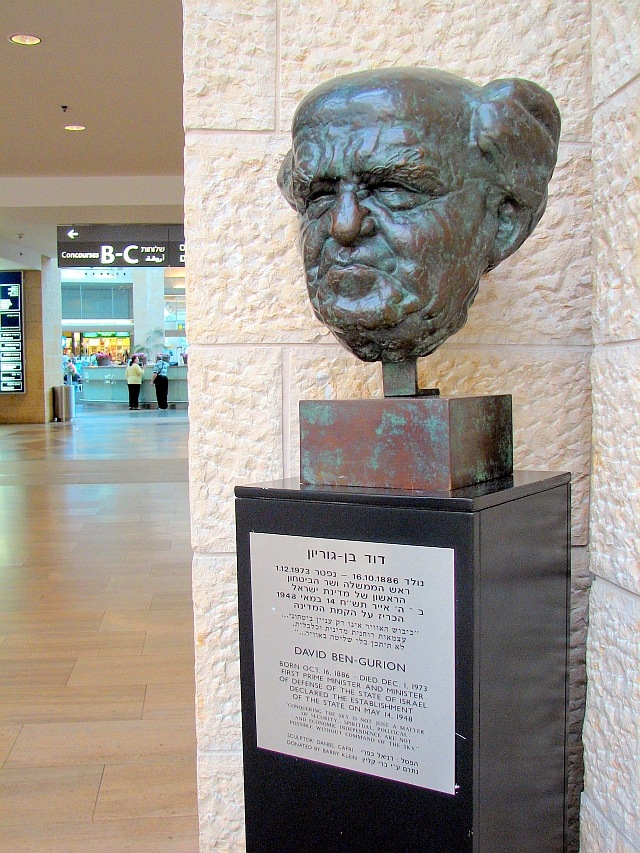

Source: Ori~
Airlines and destinations
The following airlines serve the following destinations at Ben Gurion Airport.
Passenger
| Airlines | Destinations |
|---|---|
| Aegean Airlines | Athens, Larnaca, Thessaloniki Seasonal: Heraklion, Mykonos, Rhodes |
| Aeroflot | Moscow–Sheremetyevo |
| airBaltic | Riga |
| Air Canada | Toronto–Pearson Seasonal: Montréal–Trudeau |
| Aircompany Armenia | Yerevan |
| Air Europa | Madrid |
| Air France | Paris–Charles de Gaulle Seasonal: Nice |
| Air India | Delhi |
| Air Malta | Malta |
| Air Moldova | Chișinău |
| Air Serbia | Belgrade |
| Air Seychelles | Mahé |
| Air Sinai | Cairo |
| Alitalia | Rome–Fiumicino Seasonal: Athens |
| AnadoluJet | Istanbul–Sabiha Gökçen, İzmir |
| Arkia | Athens, Barcelona, Belgrade, Bucharest, Eilat, Kochi, Larnaca, Prague, Rome–Fiumicino Seasonal: Amsterdam, Baku, Batumi, Bergamo, Bergen, Budapest, Burgas, Chișinău, Heraklion, Kos, Ljubljana, Mahé, Mykonos, Ohrid, Oslo–Gardermoen, Paphos, Paris–Charles de Gaulle, Plovdiv, Rhodes, Sofia, Strasbourg, Tbilisi, Thessaloniki, Verona, Yerevan, Zanzibar |
| ASL Airlines France | Seasonal: Paris–Charles de Gaulle |
| Austrian Airlines | Vienna |
| Azerbaijan Airlines | Baku |
| Azimuth | Rostov-on-Don |
| Belavia | Minsk |
| Blue Air | Bucharest |
| Bluebird Airways | Barcelona Seasonal: Bucharest, Budapest, Burgas, Heraklion, Kos, Larnaca, Prague, Rhodes, Thessaloniki |
| British Airways | London–Heathrow |
| Brussels Airlines | Brussels |
| Bulgaria Air | Sofia Seasonal: Burgas, Varna |
| Cathay Pacific | Hong Kong |
| Corendon Airlines Europe | Seasonal: Cologne/Bonn, Nuremberg |
| Croatia Airlines | Seasonal: Dubrovnik, Zagreb |
| Cyprus Airways | Larnaca |
| Delta Air Lines | New York–JFK |
| easyJet | Amsterdam, Berlin–Schönefeld, Berlin–Tegel, Bordeaux, London–Luton, Lyon, Manchester, Milan–Malpensa, Naples, Nice, Paris–Charles de Gaulle, Toulouse, Venice Seasonal: London–Gatwick, London–Stansted |
| easyJet Switzerland | Basel/Mulhouse, Geneva |
| El Al | Amsterdam, Athens, Bangkok–Suvarnabhumi, Barcelona, Beijing–Capital, Berlin–Schönefeld, Boston, Brussels, Bucharest, Budapest, Chicago–O’Hare (resumes 13 March 2021), Frankfurt, Geneva, Hong Kong, Johannesburg–O. R. Tambo, Kiev–Boryspil, Larnaca, Las Vegas, Lisbon, London–Heathrow, London–Luton, Los Angeles, Madrid, Marseille, Miami, Milan–Malpensa, Moscow–Domodedovo, Mumbai, Munich, Newark, New York–JFK, Nice, Paris–Charles de Gaulle, Prague, Rome–Fiumicino, San Francisco, Sofia, Tokyo-Narita (begins 8 March 2021), Toronto–Pearson, Venice, Vienna, Warsaw–Chopin, Zürich |
| Ethiopian Airlines | Addis Ababa |
| Finnair | Helsinki |
| FlyOne | Chișinău |
| Georgian Airways | Tbilisi Seasonal: Batumi |
| Hainan Airlines | Beijing–Capital, Shenzhen |
| Iberia | Madrid |
| Israir Airlines | Eilat, Larnaca Seasonal: Baku, Barcelona, Belgrade, Bergen, Berlin–Schönefeld, Burgas, Corfu, Genoa, Heraklion, Innsbruck, Ljubljana, Munich, Oslo–Gardermoen, Palma de Mallorca,[60] Poprad-Tatry, Rhodes, Riga, Rome–Fiumicino, Rovaniemi, Salzburg, Sofia, Stuttgart, Tbilisi, Tenerife–South, Thessaloniki, Tirana, Tivat, Varna, Yerevan, Zakynthos, Zürich |
| KLM | Amsterdam |
| Korean Air | Seoul–Incheon |
| LATAM Chile | Santiago de Chile, São Paulo–Guarulhos |
| Lauda | Vienna |
| LOT Polish Airlines | Gdańsk, Kraków, Lublin, Rzeszów, Warsaw–Chopin, Wrocław |
| Lufthansa | Frankfurt, Munich |
| Malta Air | Vienna |
| MyWay Airlines | Tbilisi |
| Neos | Verona |
| Norwegian Air Shuttle | Barcelona, Copenhagen, Stockholm–Arlanda |
| Pegasus Airlines | Istanbul–Sabiha Gökçen Seasonal: Antalya, Dalaman, İzmir |
| Rossiya | Saint Petersburg |
| Royal Jordanian | Amman–Queen Alia |
| RwandAir | Kigali |
| Ryanair | Athens, Bergamo, Berlin–Schönefeld, Bologna, Budapest, Charleroi, Karlsruhe/Baden-Baden, Kraków, Marseille, Memmingen, Paphos, Poznań, Rome–Fiumicino, Sofia, Thessaloniki, Vilnius, Warsaw–Modlin |
| Sichuan Airlines | Chengdu |
| SkyUp | Lviv, Zaporizhia |
| Smartwings | Prague |
| Sun d’Or | Kraków, Tbilisi Seasonal: Amsterdam, Barcelona, Batumi, Cluj-Napoca, Dubrovnik, Ljubljana, Málaga, Naples, Odessa, Paphos, Salzburg, Thessaloniki, Zagreb |
| Swiss International Air Lines | Zürich |
| TAP Air Portugal | Lisbon |
| TAROM | Bucharest |
| Transavia | Amsterdam, Eindhoven |
| Transavia France | Lyon, Paris–Orly |
| Turkish Airlines | Istanbul Seasonal: Antalya |
| Tus Airways | Larnaca |
| Ukraine International Airlines | Dnipropetrovsk, Kharkiv, Kiev–Boryspil, Odessa |
| United Airlines | Chicago–O’Hare (begins 12 September 2020), Newark, San Francisco, Washington–Dulles |
| Ural Airlines | Krasnodar, Mineralnye Vody, Moscow–Zhukovsky, Saint Petersburg, Sochi, Yekaterinburg |
| Uzbekistan Airways | Tashkent |
| Virgin Atlantic | London–Heathrow |
| Vueling | Barcelona Seasonal: Florence |
| Wizz Air | Bucharest, Budapest, Cluj-Napoca, Debrecen, Iași, Katowice, Kraków, London–Luton, Milan-Malpensa (begins 25 October 2020), Sofia, Varna, Vienna, Vilnius, Warsaw–Chopin |
Cargo
| Airlines | Destinations |
|---|---|
| CAL Cargo Air Lines | Larnaca, Liège |
| CargoLogicAir | Frankfurt, London-Stansted |
| DHL Aviation | Bergamo, Brussels, Leipzig/Halle |
| Ethiopian Airlines Cargo | Addis Ababa, Istanbul-Atatürk |
| FedEx Express | Athens, Cologne/Bonn, Munich, Paris–Charles de Gaulle |
| Korean Air Cargo | Milan–Malpensa, Seoul–Incheon, Vienna |
| Lufthansa Cargo | Frankfurt |
| MNG Airlines | Istanbul-Atatürk |
| Royal Jordanian Airlines | Amman–Queen Alia |
| Silk Way West Airlines | Baku |
| Turkish Cargo | Istanbul-Atatürk |
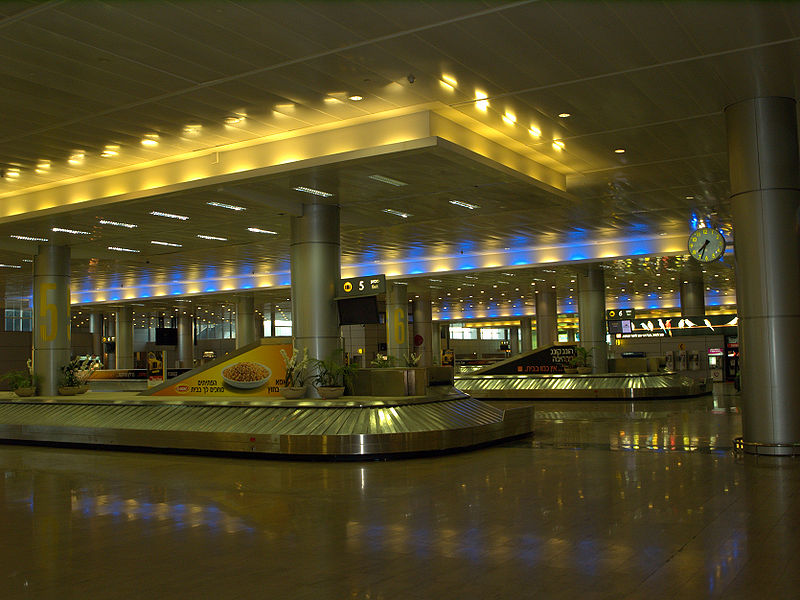

Source: David Shankbone (1974–)
Ground transportation
The airport is located near Highway 1, the main Jerusalem-Tel Aviv Highway and Highway 40. The airport is accessible by car or public bus. Israel Railways operates train service from the airport to several parts of the country and taxi stands are located outside the arrivals building. A popular transportation option is a share taxi van, known in Hebrew as a “monit sherut” (service cab), going to Jerusalem, Haifa and Beer Sheva.
Public transport
Israel has an integrated nationwide public transport payment system covering multiple transit options (train, bus and light rail) run by various operators using a single payment card: the Rav-Kav. It features flexible tariff arrangements and offers free transfers between transit methods within certain geographical zones and time periods. A public transport information office which also issues Rav-Kav cards is located in the arrivals hall of Terminal 3. With a few exceptions, most public transport options (except for taxis and service cabs) do not operate on the Sabbath (i.e., from early Friday evenings to late Saturday evenings as well as certain Jewish holidays).
Rail


Source: Cccc3333 from English Wikipedia
Israel Railways operates the Ben Gurion Airport Railway Station, located in the lower level of Terminal 3. From this station passengers may head north-west to Tel Aviv, Haifa and other destinations in the north, or south-east to Modi’in and Jerusalem. The journey to Tel Aviv Savidor Central railway station takes about 18 minutes and to Jerusalem’s Navon station about 25 minutes. There is also late night/early morning train service to and from the airport terminating at Beersheba Center via Lod, Ashkelon and selected destinations in between. Almost 3.3 million passengers used the railway line to and from the airport in 2009. The service does not operate on Shabbat and Jewish holidays but on all other days it runs day and night. The line to Nahariya through Tel Aviv and Haifa operates 24 hours a day on weekdays.
Bus or taxi
The airport is served by regular inter-city bus lines, limousine and private shuttle services, Sherut “shared” door to door taxi vans and regular taxis.[76] Afikim bus company provides 24 hours a day, on the hour, direct service to Jerusalem with line 485. the line departs from Terminal 3 on the 2nd floor and passes through Terminal 1. Egged bus number 5 ferries passengers between the terminals and a small bus terminal in the nearby Airport City business park near El Al junction just outside the airport where they can connect to regular Egged bus routes passing through the area. Passengers connecting at Airport City can pay for both rides on the same ticket, not having to pay an extra fare for bus No. 5. Other bus companies directly serve Terminal 3, and the airport also provides a free shuttle bus between terminals. On Shabbat, when there is no train service, a shared shuttle service is available between the airport and Tel Aviv hotels.
Car
Located on Highway 1, the Jerusalem – Tel Aviv highway, the airport has a total of approximately 20,000 parking spaces for short and long-term parking. The spaces for long-term parking are situated several kilometres from the terminal, and are reached by a free shuttle bus. Car rental at the airport is available from Avis, Budget, Eldan, Tamir Rental, Thrifty, Hertz and Shlomo Sixt.
Source: wikipedia
